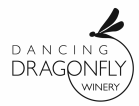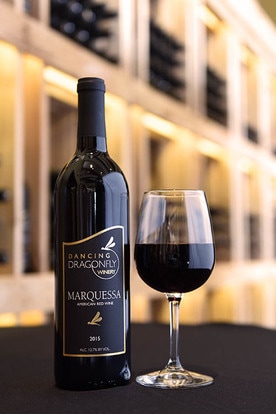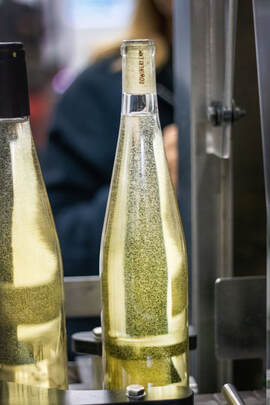WHAT IS MARQUESSA™ WINE?
|
Wines labeled as Marquessa™ wine follow a strict set of minimum standards in producing the wine. These standards are not required by the government-- they are voluntarily followed by members of the Marquessa™ Consortium-- the only wineries that can use the name Marquessa™. (In winespeak, this is a “voluntary controlled appellation.”)
Standards can change each year, as determined by the members of the Marquessa™ Consortium. The requirements for 2020 - 2022 vintages of Marquessa are: ► It must be composed of at least 75% Marquette grapes; ► It must have spent at least one year in oak barrels (for 50% or more of the component wines); and ► The vintage must be declared (which means 75% must come from that year’s vintage.) Within the constraints, the producers of Marquessa wine compete (in a collegial way) to produce the best Marquessa wine. You be the judge. |
WHAT IS THE MARQUESSA CONSORTIUM?
The Consortium is currently composed of three wineries: Dancing Dragonfly Winery, Chateau St. Croix Winery & Vineyard, and Rustic Roots Winery. These members of the consortium have agreed to maintain the high quality production standards, and submit to peer review by other members of the consortium.
WHAT IS A VOLUNTARY CONTROLLED APPELLATION?
Throughout most of the world (and particularly in the old world), winemaking is heavily regulated. Part of that regulation often involves having governments set a wide array of production standards. Those standards are typically tied to a specific geographic region. For example, the Chianti Classico region has these requirements (among others):
"Chianti Classico DOCG The heartland of the Chianti zone provides the best examples of wine in the region. Two soil types are common in the district the soft, friable, marl-like galestro and alberese, or sandstone. Sangiovese comprises a minimum 80% of the Chianti Classico blend, but may be up to 100%,. From the 2006 vintage, white grapes are no longer permitted in the wine. The minimum alcohol level for Chianti Classico is 12% (compared to 11.5% for Chianti DOCG) and the wines must age for one year prior to release. Riserva wines must be aged for a minimum 24 months, with a minimum 12.5% alc Barriques are becoming commonplace for aging riserva Chianti Classico." [1]
The United States’ version of this is the AVA (American Viticulture Area.) Unlike the controlled appellations of most other countries, however, AVA’s have very limited requirements for wines labeled from those areas. Essentially, there is only one significant AVA requirement-- If a winery wants to label its wine as being from an AVA, then 85% or more of the grapes in that wine must come from the AVA. There are no requirements for aging, barreling, or the variety of grapes used.
The Marquessa™ Consortium was formed in order to provide a higher standard that winemakers can follow, and help build the reputation of fine cold climate wine.
[1] http://www.courtofmastersommeliers.org/pdfresources/Central%20Italy.pdf
"Chianti Classico DOCG The heartland of the Chianti zone provides the best examples of wine in the region. Two soil types are common in the district the soft, friable, marl-like galestro and alberese, or sandstone. Sangiovese comprises a minimum 80% of the Chianti Classico blend, but may be up to 100%,. From the 2006 vintage, white grapes are no longer permitted in the wine. The minimum alcohol level for Chianti Classico is 12% (compared to 11.5% for Chianti DOCG) and the wines must age for one year prior to release. Riserva wines must be aged for a minimum 24 months, with a minimum 12.5% alc Barriques are becoming commonplace for aging riserva Chianti Classico." [1]
The United States’ version of this is the AVA (American Viticulture Area.) Unlike the controlled appellations of most other countries, however, AVA’s have very limited requirements for wines labeled from those areas. Essentially, there is only one significant AVA requirement-- If a winery wants to label its wine as being from an AVA, then 85% or more of the grapes in that wine must come from the AVA. There are no requirements for aging, barreling, or the variety of grapes used.
The Marquessa™ Consortium was formed in order to provide a higher standard that winemakers can follow, and help build the reputation of fine cold climate wine.
[1] http://www.courtofmastersommeliers.org/pdfresources/Central%20Italy.pdf
|
In addition to the Marquessa™ standards, the consortium also agrees to uphold these standards with two other cold climate wines. La Cressa must contain at least 75% La Crescent grapes and rest in the bottle for three months prior to its public release. Frontessa must contain at least 75% of the Frontenac Blanc grapes, and also rest in the bottle for three months prior to release.
At Dancing Dragonfly Winery, our Christine's Foxtrot is the first of the La Cressa Reserve wines under these standards. Christine's Foxtrot has a bright, floral nose, and is a wonderfully complex wine. Foxtrot starts with a touch of sweetness on the tongue, then follows with notes of apple, lemon zest, and just a touch of oak. Our Frontessa is also a mark of the Marquessa Consortium, subscribing to our rigorous winemaking standards. Frontessa is an off-dry white blend made primarily from Frontenac Blanc grapes. Soft notes of oak give way to a palate of pear and apple, and a hint of tangerine on the clean lingering finish. |



